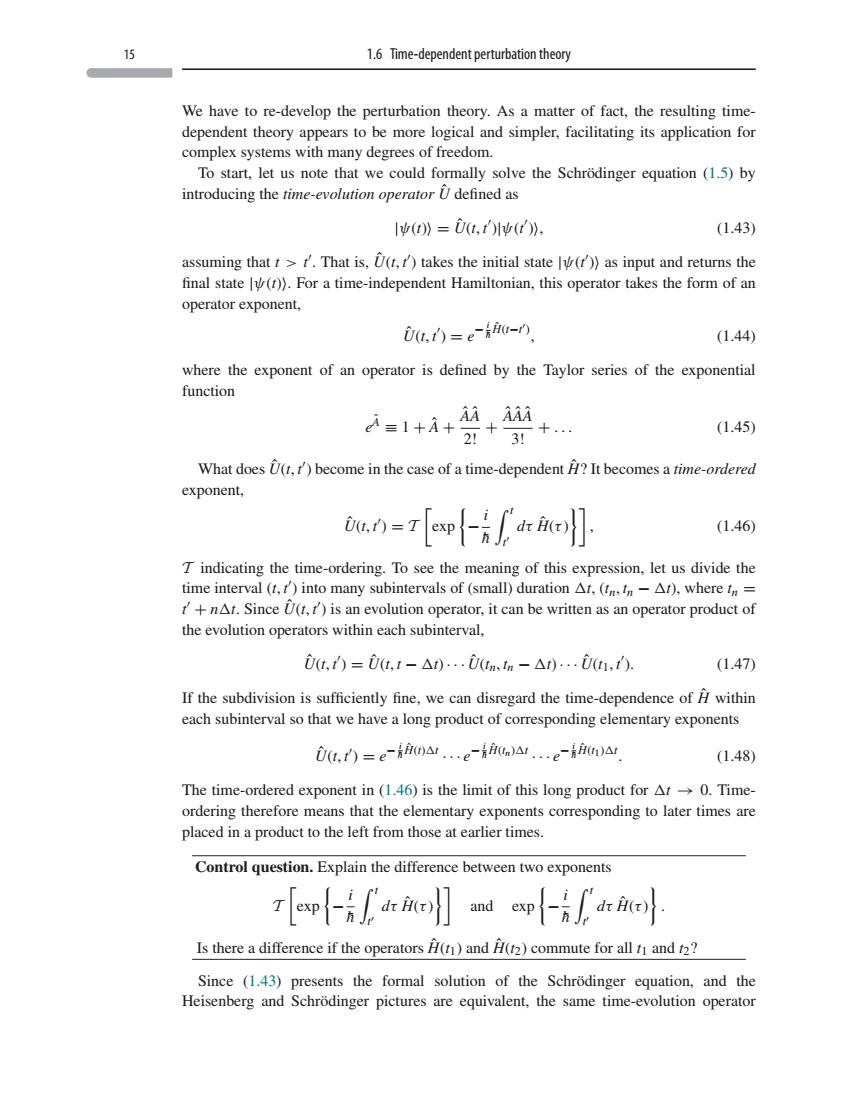正在加载图片...

1.6Time-dependent thry We have to re-develop the perturbation theory.As a matter of fact,the resulting time dependent theory appears to be more logical and simpler,facilitating its application for complex systems with many degrees of freedom. To start,let us note that we could formally solve the Schrodinger equation (1.5)by introducing the time-evolution operator U defined as 1(》=0t,)p(t)》. (1.43) assuming thatt>.That is,U()takes the initial state)as input and returns the final state()).For a time-independent Hamiltonian,this operator takes the form of an operator exponent, U(t.t)=e-i-r) (144) where the exponent of an operator is defined by the Taylor series of the exponential function =1++ AAA 2+3 (1.45) What does (t,)become in the case of a time-dependent H?It becomes a time-ordered exponent. (1.46) T indicating the time-ordering.To see the meaning of this expression,let us divide the time interval (t,)into many subintervals of(small)duration At,(nI-Ar),wheren= '+nAt.Since U(t,)is an evolution operator,it can be written as an operator product of the evolution operators within each subinterval, 0t.f=0t,t-△)…0m.n-△).0h1,t). (1.47 If the subdivision is sufficiently fine,we can disregard the time-dependence of within each subinterval so that we have a long product of corresponding elementary exponents 06,f0=ea0a.…e-)a..e-u)a (1.48) The time-ordered exponent in (1.46)is the limit of this long product for Ar0.Time- ordering therefore means that the elementary exponents corresponding to later times are placed ina product to the left from those at earlier times Control question.Explain the difference between two exponents t[esp and osp{厂ke Is there a difference if the operators (n)and H(2)commute for all and Since (1.43)presents the formal solution of the Schrodinger equation,and the Heisenberg and Schrodinger pictures are equivalent. the same lution operator 15 1.6 Time-dependent perturbation theory We have to re-develop the perturbation theory. As a matter of fact, the resulting timedependent theory appears to be more logical and simpler, facilitating its application for complex systems with many degrees of freedom. To start, let us note that we could formally solve the Schrödinger equation (1.5) by introducing the time-evolution operator Uˆ defined as |ψ(t) = Uˆ (t, t )|ψ(t ), (1.43) assuming that t > t . That is, Uˆ (t, t ) takes the initial state |ψ(t ) as input and returns the final state |ψ(t). For a time-independent Hamiltonian, this operator takes the form of an operator exponent, Uˆ (t, t ) = e − i h¯ Hˆ (t−t ) , (1.44) where the exponent of an operator is defined by the Taylor series of the exponential function eAˆ ≡ 1 + Aˆ + AˆAˆ 2! + AˆAˆAˆ 3! + ... (1.45) What does Uˆ (t, t ) become in the case of a time-dependent Hˆ ? It becomes a time-ordered exponent, Uˆ (t, t ) = T
exp − i h¯ t t dτ Hˆ (τ ) , (1.46) T indicating the time-ordering. To see the meaning of this expression, let us divide the time interval (t, t ) into many subintervals of (small) duration
t, (tn, tn −
t), where tn = t + n
t. Since Uˆ (t, t ) is an evolution operator, it can be written as an operator product of the evolution operators within each subinterval, Uˆ (t, t ) = Uˆ (t, t −
t) ··· Uˆ (tn, tn −
t) ··· Uˆ (t1, t ). (1.47) If the subdivision is sufficiently fine, we can disregard the time-dependence of Hˆ within each subinterval so that we have a long product of corresponding elementary exponents Uˆ (t, t ) = e − i h¯ Hˆ (t)
t ··· e − i h¯ Hˆ (tn)
t ··· e − i h¯ Hˆ (t1)
t . (1.48) The time-ordered exponent in (1.46) is the limit of this long product for
t → 0. Timeordering therefore means that the elementary exponents corresponding to later times are placed in a product to the left from those at earlier times. Control question. Explain the difference between two exponents T
exp − i h¯ t t dτ Hˆ (τ ) and exp − i h¯ t t dτ Hˆ (τ ) . Is there a difference if the operators Hˆ (t1) and Hˆ (t2) commute for all t1 and t2? Since (1.43) presents the formal solution of the Schrödinger equation, and the Heisenberg and Schrödinger pictures are equivalent, the same time-evolution operator���